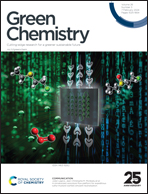Sustainable photocatalytic synthesis of hydrogen peroxide from catechol-formaldehyde resin microspheres modulated by nitrogen-doped carbon dots†
Abstract
Compared with traditional anthraquinone oxidation, the photocatalytic 2-electron ORR is an environmentally friendly and efficient alternative to H2O2 production. Herein, low-temperature hydrothermally synthesized catechol-formaldehyde resin (CFR) microspheres were readily available as a green energy-saving catalyst, which has the ability to achieve the chemical conversion of O2 to H2O2 without the need for any external energy sources and electron donors. In order to further improve the catalytic performance, we propose a new design of a composite photocatalyst, namely CFR/NCDs-220, which improves the defects of CFR microspheres by combining with nitrogen-doped carbon dots (NCDs-220) of strong reducing ability with the assistance of sunlight, and has become a new candidate for the green and sustainable photoproduction of H2O2. The optimal catalyst produced 64 μmol H2O2 within 6 h under visible light irradiation with enhanced catalyst cycle stability and H2O2 selectivity owing to the photoexcited NCDs-220 acting as the electron donor for o-benzoquinone in the CFR microspheres. The solar-chemical conversion (SCC) efficiency of CFR/NCDs-220 for the photoproduction of H2O2 can reach 1.06% within 3 h without any sacrificial agent. The addition of NCDs-220 can achieve the reversible conversion of catechol and o-benzoquinone, thus ameliorating the photogeneration performance of H2O2 by the CFR microspheres. CFR/NCDs-220 exhibited a 2-electron reduction path in visible light and a heightened selectivity for H2O2 from 23% to 65%. This work highlights the use of solar-assisted NCDs-220 to power the CFR-chemically-catalyzed O2 to H2O2 conversion with long-term cycle stability, providing a simple strategy for the design of catalysts for H2O2 production.



 Please wait while we load your content...
Please wait while we load your content...